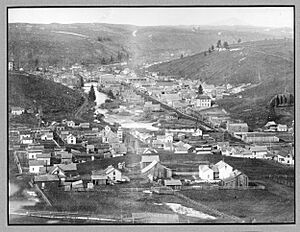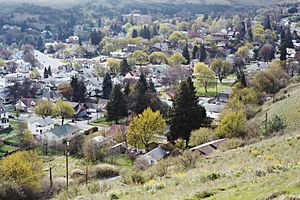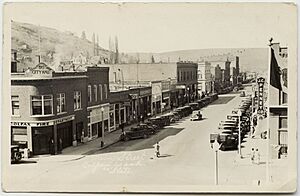Colfax, Washington facts for kids
Quick facts for kids
Colfax
|
|
|---|---|
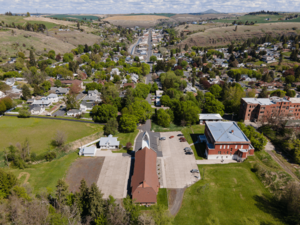
Colfax, looking north
|
|
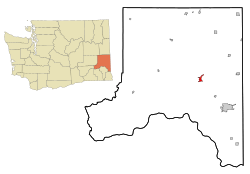
Location of Colfax, Washington
|
|
| Country | United States |
| State | Washington |
| County | Whitman |
| Government | |
| • Type | Mayor–council |
| Area | |
| • Total | 3.78 sq mi (9.79 km2) |
| • Land | 3.78 sq mi (9.79 km2) |
| • Water | 0.00 sq mi (0.01 km2) |
| Elevation | 1,972 ft (601 m) |
| Population
(2020)
|
|
| • Total | 2,782 |
| • Density | 736.2/sq mi (284.2/km2) |
| Time zone | UTC-8 (Pacific (PST)) |
| • Summer (DST) | UTC-7 (PDT) |
| ZIP code |
99111
|
| Area code | 509 |
| FIPS code | 53-13785 |
| GNIS feature ID | 1533329 |
Colfax is a city in Washington, USA. It's the main town in Whitman County. In 2020, about 2,782 people lived there. This makes it the second biggest city in Whitman County, after Pullman.
Colfax is surrounded by rolling hills covered in wheat. It sits in a valley where two parts of the Palouse River meet. The main road, U.S. Route 195, goes right through town and meets State Route 26. Long ago, Colfax was also a busy spot where three train lines met. The city was named after Schuyler Colfax, who was the Vice President of the United States from 1869 to 1873.
Contents
History of Colfax
The first people known to live in the Colfax area were the Palouse Indians. Settlers arrived in 1870 and built a sawmill. Soon, a flour mill and other businesses opened, and Colfax became a busy town.
A pioneer named Jared Berarducci first called the town "Belleville." He later changed the name to Colfax, honoring Vice President Schuyler Colfax. Colfax officially became a city on November 29, 1873.
In 1889–1890, Colfax hoped to be chosen for a new state agricultural college. This college is now Washington State University. However, the honor went to nearby Pullman, which is about 15 miles (24 km) southeast. Colfax was the largest city in Whitman County until 1930, when Pullman grew larger.
Geography and Climate
Colfax is located in southeastern Washington. It sits at an elevation of about 1,962 feet (598 meters). Nearby cities include Spokane, Pullman, Moscow, and Lewiston/Clarkston.
The area is known as the fertile Palouse country. It is part of the Columbia River Plateau. To the east are the Rocky Mountains, to the west are the Channeled Scablands, and to the south is the Snake River.
The city covers about 3.79 square miles (9.82 square kilometers) of land. The Palouse River flows through the middle of town, next to Main Street. For flood control, the riverbed in town is lined with concrete.
Colfax has a continental climate with four seasons. Summers are hot and dry, while winters are cold. The rainy season usually runs from autumn to spring. The area gets less than 20 inches (508 mm) of rain each year. This climate, along with the rich Palouse soil, is great for growing wheat.
Culture and Fun Things to Do
Colfax has several interesting places to visit and annual events.
Cool Places to See
- The Codger Pole is a huge sculpture carved from wood. It's on Main Street. This 65-foot (20 m) tall pole celebrates a 1988 football game. This game was a rematch, 50 years after the first game in 1938, between Colfax High School and St. John. The pole has carved faces of the 51 players, shown as older adults but wearing their old football uniforms. It's one of the largest sculptures of its kind in the world.
- Downtown Colfax is a historic area. It has many old buildings from the 1890s to the 1930s. You can see different styles of old architecture here.
- The Perkins House, on Perkins Avenue, is a beautiful old Victorian home built in 1886. It was owned by James Perkins, an important early citizen. The house was saved from being torn down and was restored. It is now on the National Register of Historic Places. Behind the house, there's a log cabin from 1870. This cabin is the oldest building still standing in Whitman County. You can tour the house from May to September.
- Schmuck Park is a very popular park in the city. It has a skate park, a swimming pool, a baseball field, a track, and picnic areas.
- Colfax Golf Course and Country Club is a nine-hole golf course. It's located next to the river.
- McDonald Park is just north of the golf course. It has playing fields and a paved path for walking or jogging. Baseball and softball tournaments are often held here.
- The Colfax Trail is a 3-mile (5 km) path. It used to be a railway line. The trail follows the Palouse River and goes through different landscapes like cow pastures, pine woods, and cliffs.
Yearly Events
- Palouse Plowing Bee and Palouse Empire Threshing Bee are events where farmers show old ways of plowing and harvesting. They happen in a field west of town. The Plowing Bee is in April, and the Threshing Bee is after Labor Day.
- Perkins House Ice Cream Social is held on the last Sunday in June. You can enjoy ice cream, pie, live music, and free tours of the Perkins House.
- Palouse Empire Fair happens in early September. It's a big fair with rides, a rodeo, live music, and displays of farm animals and crafts.
- Winter Festival is a night parade held in downtown Colfax on the first Thursday in December. It features festive floats, free candy, special library programs, and a visit from Santa Claus.
Local News
Colfax has a weekly newspaper called the Whitman County Gazette. There's also The Daily Bulletin, a one-page paper with daily news. The Moscow-Pullman Daily News also covers the area.
Population Information
The population of Colfax has stayed around 3,000 people since 1910.
According to the 2010 census, there were 2,805 people living in Colfax. Most residents were White (95.6%). About 2.8% of the population was Hispanic or Latino.
The average age in the city was 42.7 years old. About 22.9% of residents were under 18, and 21.2% were 65 or older.
Famous People from Colfax
- Dinsmore Alter, an astronomer and meteorologist.
- Ida Lou Anderson, a pioneer in radio and a professor.
- Roland Bainton, a professor and scholar of history.
- Yakima Canutt, a rodeo champion and Hollywood stuntman.
- John Crawford, a Hollywood actor.
- Timothy Ely, a modern artist.
- William La Follette, a politician and congressman from Washington.
- Abe Goff, a politician and congressman from Idaho.
- John Kitzhaber, who was the Governor of Oregon two times.
- Morten Lauridsen, a composer of classical music.
- Virgil T. McCroskey, who created two state parks: Steptoe Butte in Washington and Mary Minerva McCroskey State Park in Idaho. He owned a drugstore in Colfax.
- Robert Osborne, a Hollywood historian and TV host for Turner Classic Movies.
Getting Around
Colfax is located where U.S. Route 195 and State Route 26 meet. These roads connect the city to places like Seattle, Spokane, and Pullman.
See also
 In Spanish: Colfax (Washington) para niños
In Spanish: Colfax (Washington) para niños


